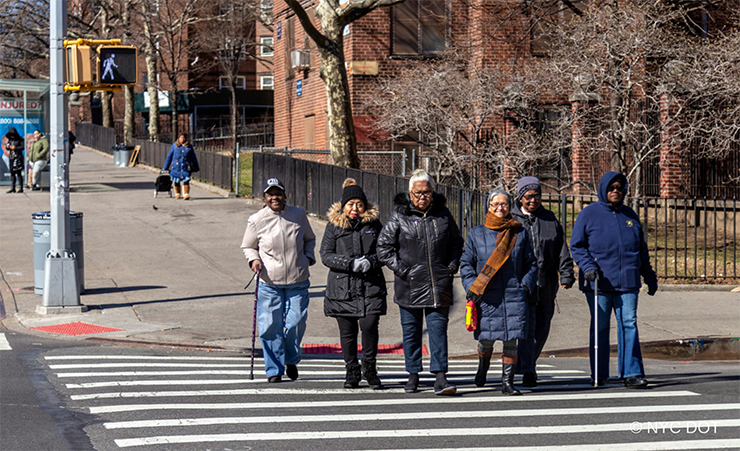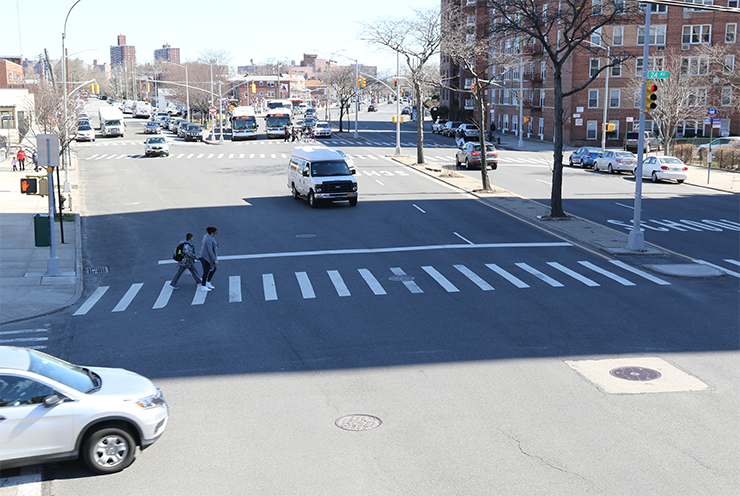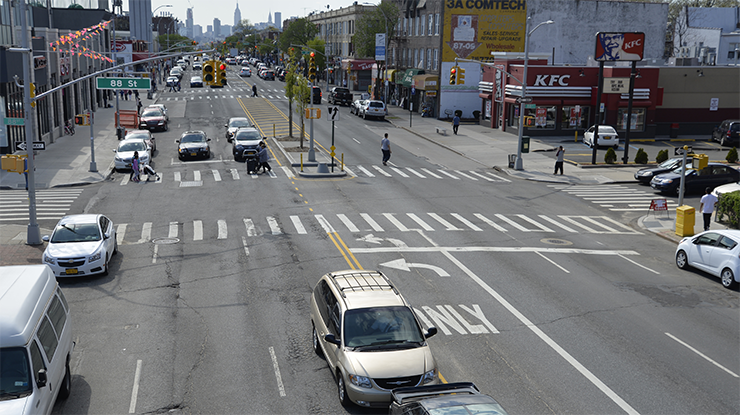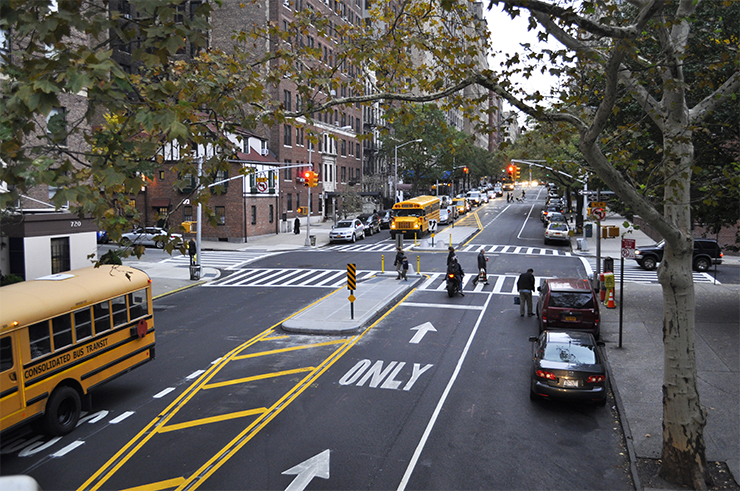Safe Streets for Seniors
Safe Streets for Seniors is a pedestrian safety initiative for older New Yorkers. The Safe Streets for Seniors program studies crash data, conducts outreach, and develops and implements mitigation measures to improve the safety of seniors and other pedestrians, as well as all road users as part of New York City’s Vision Zero initiative.
NYC DOT evaluates pedestrian conditions in priority neighborhoods from a senior's perspective and implements safety improvements. Such improvements include extending pedestrian crossing times at crosswalks to accommodate slower walking speeds, constructing pedestrian safety islands, widening curbs and medians, narrowing roadways, and installing new stop controls and signals. NYC DOT frequently applies for and has received numerous federal grants to construct these safety improvements and bring targeted benefits to our most vulnerable population.

Pedestrian Safety and Older New Yorkers


In 2022, NYC DOT released Pedestrian Safety and Older New Yorkers to understand the changing trends and vulnerabilities of senior pedestrians in New York City. This comprehensive study of senior pedestrian fatalities and injuries found that seniors, though the fastest growing age-group in New York City, currently represent less than 15% of New York City’s population but over 45% of pedestrian fatalities. Through this study, NYC DOT updated its Senior Pedestrian Zones throughout the city (replacing the original 41 Senior Pedestrian Focus Areas). The updated Senior Pedestrian Zones account for 19% of the citywide senior population but 31% of citywide senior pedestrian fatalities or severe injuries and 33% of citywide senior pedestrian injuries.
We learned that senior pedestrians are very similar to non-senior adults in their behavior and crash patterns, and that they generally use our streets much like the rest of the population. They are struck no more often than younger pedestrians; however, when they are involved in a crash, they suffer far worse outcomes. Since even seemingly minor crashes for seniors can lead to severe injuries and fatalities, total avoidance of crashes must be NYC DOT’s primary street design goal. This study also analyzed the impacts of previous NYC DOT Street Improvement Projects (SIPs) on both the citywide pedestrian population and senior pedestrian populations. This analysis will guide ongoing safety improvements that NYC DOT will implement within these Senior Pedestrian Zones.
As a result of the Pedestrian Safety and Older New Yorkers study, NYC DOT, with the assistance of NYPD, created the following 17-step action plan to address senior pedestrian safety:
- Create Senior Pedestrian Zones to guide engineering, enforcement, and education
- Extend exclusive pedestrian crossing time (LPIs) during mid-day in Senior Pedestrian Zones by the end of 2024
- Add exclusive pedestrian crossing time (LPIs) at all feasible intersections on Priority Corridors in Senior Pedestrian Zones by the end of 2024
- Extend exclusive pedestrian crossing time (LPIs) during mid-day for all new LPIs
- Create Senior Turn Calming initiative and install treatments at 50 intersections annually
- Implement ten or more Senior Street Improvement Projects annually
- Target Raised Crosswalks to senior pedestrians
- Target safety improvements to bus stop locations under elevated trains
- Continue to improve safety for senior pedestrians in Midtown
- Target Senior Safety Education and Outreach to Senior Pedestrian Zones
- Work with medical providers on senior pedestrian outreach
- Add senior pedestrian crash data to Vision Zero View
- Conduct outreach to Senior Pedestrian Zone stakeholders
- NYPD will conduct senior pedestrian safety enforcement initiatives focusing on daytime hours and the Senior Pedestrian Zones
- NYPD will continue to identify seniors with head injuries for enhanced crash investigations
- Advocate for vehicle designs that increase pedestrian visibility
- Advocate for mandatory inclusion of safety-focused driver assistance technologies in all new vehicles.
The findings and plans laid out in this report will guide NYC DOT’s actions focused on improving safety for senior pedestrians. Through this plan, NYC DOT’s work benefiting our most vulnerable road users will help the city move towards our goal of eliminating fatalities and severe injuries on the streets of New York.
Previous Work
NYC DOT has made hundreds of changes to improve senior pedestrian safety across the city, identifying Senior Pedestrian Focus Areas (SPFAs) through an analysis of senior pedestrian crashes resulting in fatalities or severe injuries as well as variables such as senior trip generators, concentrations of senior centers and housing locations. Since launching the Safe Streets for Seniors Program in 2009, NYC DOT has addressed senior pedestrian safety issues within 41 Senior Pedestrian Focus Areas (SPFAs) in the five boroughs. NYC DOT has re-timed signals in order to provide pedestrians more time to cross the street, installed countdown timers and audible pedestrian signals, reconstructed pedestrian ramps to be ADA-compliant, upgraded roadway markings, and installed nearly 200 Turn Calming treatments within the 41 SPFAs. Additionally, NYC DOT has implemented 300 Street Improvement Projects within the 41 SPFAs that address unique roadway conditions to improve safety conditions for all roadway users with a particular focus on benefits for senior pedestrians. Some examples are below:
Cropsey Avenue, Brooklyn, 2018


Treatments: Added bus boarding island, paint and concrete median tips, pedestrian refuge islands, and markings upgrades
Impacts: Total injuries decreased by 45%, pedestrian injuries by 67%
Sheepshead Bay Road, Brooklyn, 2016


Treatments: Closed slip lanes, added concrete pedestrian refuges, one-way conversions, added pedestrian plaza space, signal timing changes
Impacts: Total injuries decreased by 18%, crashes with injuries decreased by 24%
Northern Boulevard, Queens, 2014


Treatments: Added 9 pedestrian refuge islands, left turn bays, changed signal timing, upgraded crosswalks
Impacts: Pedestrian injuries decreased by 30%, total injuries decreased by 12%
West End Avenue, Manhattan, 2014


Treatments: Removed one travel lane in each direction, added left turn bays and wide parking lane stripes, installed 4 pedestrian refuge islands
Impacts: Pedestrian injuries decreased by 45%, total injuries decreased by 29%
